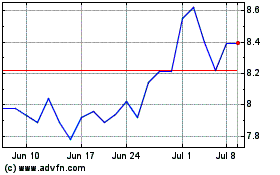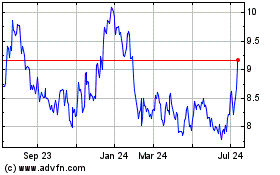Fed Targets Banks Over 'Amend-And-Pretend' Loans
April 14 2010 - 4:36PM
Dow Jones News
The Federal Reserve is taking aim at a banking practice known as
"amend and pretend."
That's what bankers call the desperate strategy of extending or
restructuring failing loans that are likely to eventually fail
anyway, usually to delay the reckoning of hefty losses.
Of the Federal Reserve's public enforcement actions against
banks this year, more than a third, or 22, include provisions that
strictly limit the banks' ability to change loan terms for troubled
borrowers without first getting approval from the banks' boards of
directors. The regulatory agreements also note the Fed's specific
concerns about restructured loans to bank insiders.
First Banks Inc. in Clayton, Mo., is one notable example of the
recent Fed enforcement actions.
Less than two years ago, the U.S. Treasury used its Troubled
Asset Relief Program, or TARP, to give the bank some $295 million
in government funds--or more TARP funds than any other privately
held bank. At least four other banks that received TARP funds are
subject to the recent Fed actions.
Troubled TARP banks carry a tandem of risks for U.S. banking
regulators, since failures can drain the government's deposit
insurance fund, and also turn government investments in banks into
losses.
In early April, the Federal Reserve disclosed First Banks had
signed an enforcement action in which the Fed mandated First Banks
and its affiliates "shall not...extend, renew or restructure any"
of the bank's troubled loans "without the prior approval of a
majority of the full board of directors."
Terrance McCarthy, First Banks chief executive, said: "The
language in the provision...is almost identical to what was used by
regulators 20 years ago" during the last banking crisis. "We don't
consider it a limitation." He added, "Banks are not prohibited from
extending problem loans if it's in the interest of the bank for the
best collection of the loan."
First Banks' agreement with regulators marks the latest chapter
in the bank's rise-and-stumble trip through the credit bubble and
financial crisis.
During 2005 to 2007, the bank expanded in California, Florida
and Illinois--now three hotbeds of the banking crisis--and also
made big bets on commercial real-estate loans. The bank did well
for a while, producing profit of $112 million in 2006.
Early last year, in a letter to TARP Inspector General Neil
Barofsky, McCarthy said the bank had renewed $157.8 million in
construction loans in January and February of 2009.
But by the end of last year, First Banks faced piles of failing
loans. The bank lost $449 million in 2009--or about four years'
worth of boom-time profits. In last year's fourth quarter, First
Banks took $122 million in losses just from loans tied to
construction projects.
Asked about the renewals, McCarthy said: "We regularly extend
loans where there's a prudent course to do so. You'll find that at
any bank working their way through the cycle."
The Federal Reserve has signed similar agreements with four
other banks that received TARP. They are Heritage Commerce Corp.
(HTBK), which received $40 million; Bankers' Bank of the West
Bancorp Inc., which received $13 million; Idaho Bancorp (IDBC),
which received $7 million; and Rising Sun Bancorp, which received
$6 million.
The banks didn't have any immediate comment.
It can be nearly impossible to see from publicly available data
which banks are extending or restructuring loans they believe will
one day fail anyway. But bankers are privately adamant that many
struggling banks are using amend-and-pretend strategies to delay
coming losses, especially from commercial real-estate loans.
Extending highly distressed loans can have two significant
effects in the broader banking system. First, extending troubled
loans can conceal coming losses and lead to costlier bank failures
that strain deposit insurance funds at the Federal Deposit
Insurance Corp.
But lenders also risk becoming "zombie banks" when they extend
or restructure too many failing loans. That's because when lenders
know they're at high risk of loss, they have little incentive to
make new, sounder loans, since they know they'll eventually need
their capital to offset losses.
-By Marshall Eckblad, Dow Jones Newswires; 212-416-2156;
marshall.eckblad@dowjones.com
Heritage Commerce (NASDAQ:HTBK)
Historical Stock Chart
From Mar 2024 to Apr 2024

Heritage Commerce (NASDAQ:HTBK)
Historical Stock Chart
From Apr 2023 to Apr 2024
